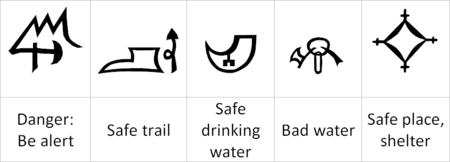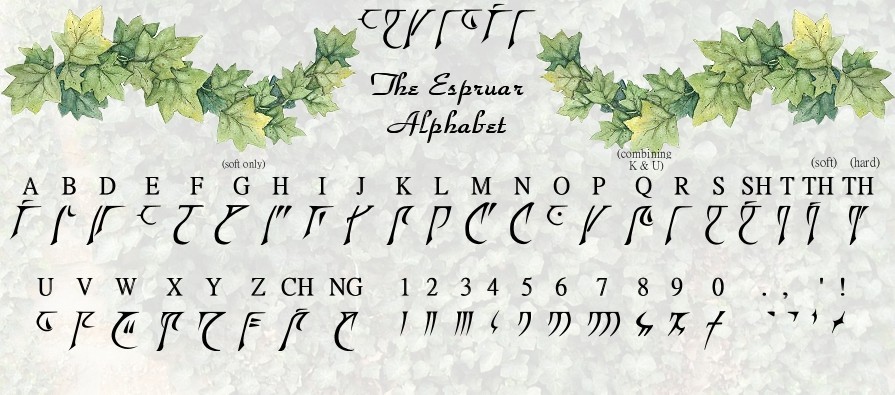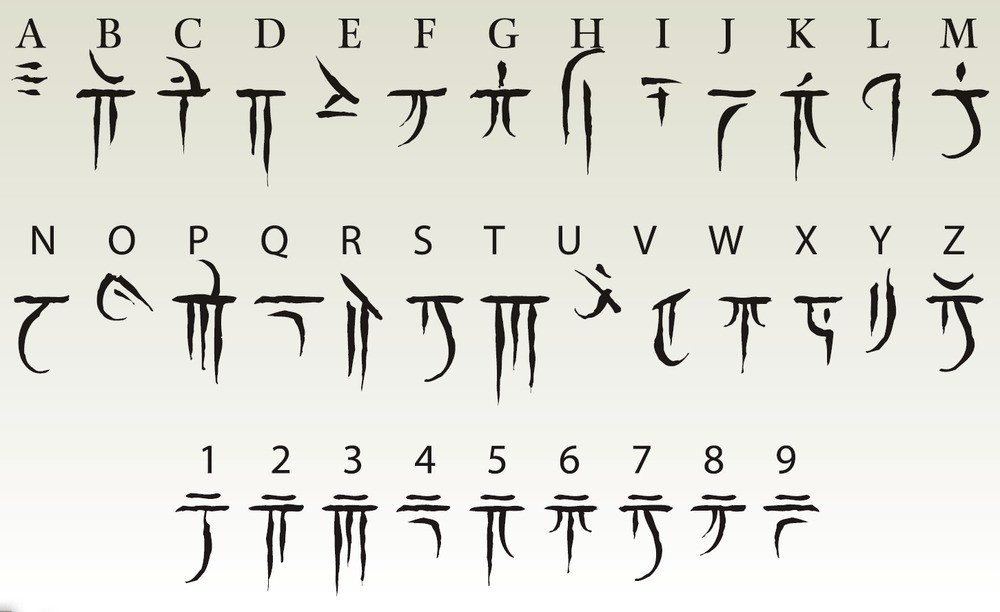See the Linguistics skill for details on how a character communicates with a language. Consult with your GM to choose an uncommon and especially a rare language.
Table of contents
| Language | Typical speakers | Script |
|---|---|---|
| Common languages | ||
| Common | Humans | Common |
| Dwarven | Dwarves | Dethek |
| Elvish | Elves | Espruar |
| Gnomish | Gnomes | Espruar |
| Hin | Hin | Common |
| Uncommon languages | ||
| Aquan | Creatures from the Plane of Water | Iokharic |
| Auran | Creatures from the Plane of Air | Iokharic |
| Draconic | Dragons, Kobold, Ssurran, Vayemniri, Nagaji | Iokharic |
| Goblin | Goblinoids | Dethek |
| Ignan | Creatures from the Plane of Fire | Iokharic |
| Jotun | Ogres, Giants | Dethek |
| Kreen | Thri-Kreen | Kreen |
| Orcish | Orcs | Dethek |
| Sylvan | Fey | Espruar |
| Terran | Creatures from the Plane of Earth | Iokharic |
| Rare languages | ||
| Abyssal | Demons | Infernal |
| Aklo | Mind Flayers, Neothelids, Beholders | — |
| Celestial | Celestials | Celestial |
| Duergan | Duergar | Dethek |
| Gith | Githyanki, Githzerai | Gith |
| Infernal | Devils | Infernal |
| Undercommon | Underdark creatures | Espruar |
Common languages
Common
Common is the trade language of the world. Most of the people of the world have a capacity to converse with each other in this common language.
Dwarven
Dwarven is a clipped language of hard consonants and guttural pronunciation. Dwarven shares its runic alphabet with Terran, along with a number of other similarities.
Elvish
Elvish is believed to be among the eldest, if not the eldest of the languages mortals speak. Scholars conjecture that it was formed when elven speakers of Sylvan tried to introduce grammatical rules and vocabulary from both Celestial and Draconic. Elvish is a complex language, but sounds poetic in tone and cadence. Elven literature is rich and varied, and their songs and poems are famous among other species. Many bards learn their language so they can add Elven ballads to their repertoires.
Gnomish
In terms of the sheer number of words in its vocabulary, Gnomish, is the largest language known. It has changed dramatically since its creation, a process which has by no means halted. The Gnomish language, is renowned for its technical treatises and its catalogs of knowledge about the natural world. It shares certain similarities with both Aklo and Sylvan.
Hin
Hin has many regional dialects to the point that hin may find difficulty communicating with foreign hin in complex areas. The Hin language isn’t secret, but hin are loath to share it with others. They write very little, so they don’t have a rich body of literature.
Their oral tradition, however, is very strong. Almost all hin speak Common to converse with the people in whose lands they dwell or through which they are travelling.
Uncommon languages
Aquan
Aquan, from the Plane of Water, grew from a proto-primordial language which was the progenitor of all primordial languages. Like all primordial languages, Aquan sentences always begin with the subject, followed by the object and the verb. Much of its vocabulary is taken up with water-related terms. It is a guttural language with many long syllables made up of dense, throaty sounds, with affixes and inflections providing subtle shifts in meaning.
Auran
Auran, from the Plane of Air, grew from a proto-primordial language which was the progenitor of all primordial languages. Like all primordial languages, Auran sentences always begin with the subject, followed by the object and the verb. It is a soft-spoken, breathy and relaxed language that can been described as a slow exhaling of air.
Draconic
Draconic is believed to be among the oldest, if not the oldest language of the multiverse and is often used in the study of magic. Because of this, nearly all other languages can trace some roots back to this primordial tongue. The language sounds harsh to most other creatures and includes numerous hard consonants and sibilants.
Goblin
Goblin vocabulary is shared by the goblin, bugbear, and hobgoblin species, even if the pronunciations, inflections, and usage differs wildly among them. When spoken by goblins, it is nearly incomprehensible to outsiders, and sounds more like high-pitched yapping. Among the hobgoblins, it takes the form of short, barked commands, while the bugbears speak their taunts with a sibilance not heard among the other goblinoid species. It is an extremely flexible language, containing a plethora of terms related to subservience, fear, and death.
Ignan
Ignan, from the Plane of Fire, grew from a proto-primordial language which was the progenitor of all primordial languages. Like all primordial languages, Ignan sentences always begin with the subject, followed by the object and the verb. Ignan is a quick, percussive language, full of sharp clicks and hisses that is said to emulate the popping of a fire.
Jotun
Jotun is an ancient language of most of the giants. It was one of the oldest active languages.
Kreen
The Kreen language is very different from those of the other intelligent species. They have no lips or tongues, and so cannot make the same sounds humanoids make. Kreen language is made up of clicks, pops, or grinding noises.
Orcish
Orcish is a harsh and violent language, full of sharp delivery and hard consonants.
Sylvan
The language of the fey, Sylvan is one of the most linguistically static of all languages. Thought to be nearly as old as Draconic or Abyssal, Sylvan has a tiny vocabulary, which has barely changed over the eons.
Terran
Terran, from the Plane of Earth, grew from a proto-primordial language which was the progenitor of all primordial languages. Like all primordial languages, Terran sentences always begin with the subject, followed by the object and the verb. The Terran language is a rumbling language with deep tones that reverberate through the listener. It is an extremely slow language and not meant to be rushed.
Rare languages
Abyssal
Abyssal is believed to be among the oldest, if not the oldest language of the multiverse. Given the incredible rate of change within the tongue, this is very difficult to prove. Although it is the native language of the demons of the Abyss, it is also spoken by many devils, yugoloths, or others who have frequent dealings with species of the lower realms.
Aklo
Aklo is a language found in remote pockets of the underdark, and is thought to have otherworldly origins. Mortals struggle to learn and speak it.
Celestial
Celestial shares aspects of its structure with both Sylvan and Draconic, with few voiced consonants and lightly voiced vowels.
Duergan
Duergan is a dialect of Dwarven that originated from Shanatan, the dialect of the shield dwarves. Since the split, Duergan has changed dramatically. It is one of the most altered Dwarven dialects. The drow and illithid influences in this dialect are hard to ignore, having altered its vocabulary and grammatical structure.
Gith
Gith has two main dialects and accents: one spoken by the githyanki, and the other by the githzerai. The main writing system of the Gith language is called tir’su. It consists of arranging each word as a circular pattern, also called a tir’su, with each letter constituting a “spoke” of the wheel. Sentences and phrases were formed by connecting several individual tir’su.
The two Gith dialects differ not only in the accent, but also in the usage of the writing system. In the githyanki dialect, each word is written clockwise, starting from the top. The githzerai dialect starts each word from the bottom, filling the wheel counter-clockwise.
Infernal
Infernal is a concise language which requires precise speech. It contains many homophones in its vocabulary, leading to great confusion among novice speakers, as similar-sounding words can have widely varying meaning. Infernal is spoken predominantly in Hell and by those who traffic with it.
Undercommon
Undercommon is the trade language of the underdark. Almost all of the intelligent underdark creatures speak the undercommon. It evolved from elvish and was repurposed by the drow over the centuries to fit their new homelands. It is a combination of elvish, dwarven, surface common, and even it has the mixture of some goblin language and the other lesser words thrown in.
Scripts
Dethek
Dethek is the name of a runic script used by many languages. It consists of letters, numerals and symbols for common words or phrases.
Alphabet
The Dethek runic alphabet consists of 24 characters. The sounds “w”, “x”, and “z” are represented by the same character. This might be confusing for humans trying to translate into Common. It is not an issue for native Dethek users, as few words in those languages have these letters.

Numerals
The Dethek method of counting uses a collection of straight lines, joined together to create a number. This means that each number appears as a single character. The characters for 1 and 5 are combined in various logical ways to create the numbers 1 to 9:

The characters for 1, 5, and 10 are combined to created numbers up to 20:

Numbers from 20 to 99 can be created using logical combinations of the 1, 5, and 10 symbols:

To make 100, simply invert a 10 on top of itself (10×10=100). The rest of the hundreds could be created using combinations of previous symbols:

To make 1000, flip a 10 symbol on its side in front of 100 (10×10×10=1000). Additional thousands are added with a notch in the flipped thousand symbol:

Symbols
Clans and tribes and some of the most common words, species, or phrases have their own symbols. These are useful for sign-posting or creating runestones. Each of the main species has a collective symbol assigned to it. The symbol applied to both singular and plural, leaving the reader to work it out from context:

Other symbols are used for tracking and signposting. These were hieroglyphics based on commonly understood concepts: a foot to mark a safe trail, an inverted helm or drinking horn to indicate fresh water, and so on:

Others were “Marthammor Marks”, after the dwarven god Marthammor Duin, the Finder-of-Trails.
Punctuation
Dethek is extremely lacking in punctuation. This is probably due to the fact that dwarves rarely recorded anything more than simple instructions, warnings, or spells. The first letters of nouns and words that began sentences could be capitalized. This was achieved with a simple horizontal accent over the letter:

Words are generally separated by spaces. To end sentences, the most common method is a large line or slash across the line. To emphasize or show contrast against the writing surface, the runes could be painted. Names of people, species, and locations are highlighted in red, while the rest of the text is painted black or left unadorned. Any numbers enclosed in boxes are dates, written as day followed by year. Emotional content could be represented in how the runes are oriented, such as how the dwarven warhammer Oath-Hammer was marked in slanted runes to express the rage of its creator.
Application
Dwarf-written Dethek runes are preferably carved into durable stone, less often into metal, and rarely written on paper or cloth due to the short life and fragile nature of such materials. Dwarven runes are usually carved or scraped into the stone walls of a building or cave; on a cairn, pillar, or standing stone, or inscribed or stamped on metal surfaces such as a weapon. Particular forms of dwarven writing were books of bound metal sheets or on stone tablets called runestones.
The simplicity of Dethek runes and their straight lines make carving them into metal and stone simple. Despite this, runes inscribed on runestones are typically written in a spiral-form, from outside in.
Examples
This example shows Dethek letters, symbols, and punctuation:

This piece of text shows how written stories using the collective symbols can be misinterpreted:

Depending on how one wanted to tell the story, this passage could be read in two ways:
Durlag slew the dragon with ease.
Durlag slew the dragons with ease.
Espruar
Espruar is the name of a script used by many languages. It consists of letters and numerals. It is a graceful and fluid script.

Iokharic
Iokharic is the name of a script used by the Draconic language, as well as by the primodial languard Aquan, Auran, Ignan, and Terran. It consists of runic characters equivalent to letters and numbers in human scripts.

Dragons believe Iokharic was created by the dragon god Asgorath so his creations could record their impressions of the world he hoped they would inherit. Non-dragon scholars believed Iokharic was likely created long after its spoken form was standardized, as dragons had little need to write like other species. The script was believed to have been influenced by the dwarven runes, but dragons themselves dismissed such a connection.
Elven scholars had the theory that kobolds, rather than dwarves, were the ones who actually created Iokharic, as it was widely believed that the earliest kobolds served dragons, learning dragon ways. The oldest historical records of kobold history began with paintings, then pictograms, and gradually developed into the Iokharic script.